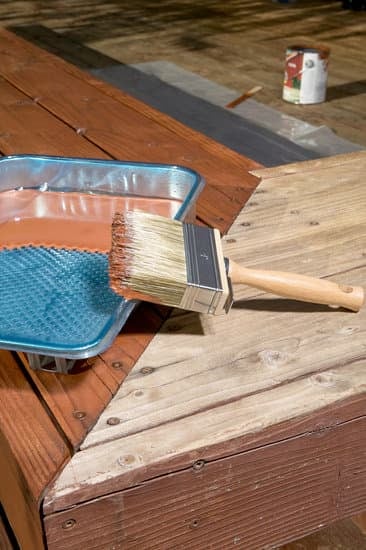Home improvements can provide a range of benefits, from enhancing the comfort and functionality of our homes to increasing their market value. But did you know that certain home improvements may also be eligible for tax deductions? Understanding the concept of tax deductibles and how they apply to home improvements is essential for homeowners looking to maximize their financial advantages.
In this article, we will explore the intricacies of tax deductions for home improvements and shed light on what expenses may qualify. We will discuss the importance of proper documentation to support deduction claims and provide real-life examples of eligible projects. Additionally, we will address any limitations or restrictions imposed on tax deductions, such as maximum amounts or income thresholds.
For those who own rental or income-generating properties, we will delve into the unique considerations when it comes to deductible home improvements. Furthermore, we will explore other potential tax benefits related to home improvements beyond just deductions, such as energy efficiency credits or historic preservation incentives.
However, it is vital to note that navigating the world of tax deductions can be complex. That’s why it is always wise to consult a tax professional before proceeding with any deduction claims. They can provide accurate advice tailored to your specific circumstances and ensure compliance with all applicable laws and regulations.
By understanding the significance of tax deductibles for home improvements, homeowners can make informed decisions that not only enhance their living spaces but also yield financial advantages. So let’s dive into this guide and discover how you could potentially save money while transforming your home.
Understanding the Basics
Tax deductions can be a valuable tool for homeowners looking to save money on their home improvement projects. Understanding the basics of tax deductions and how they work in relation to home improvements is essential for maximizing potential savings.
A tax deduction is a reduction in the amount of income that is subject to taxation. It allows homeowners to subtract certain expenses from their taxable income, ultimately lowering the amount of taxes owed. Home improvements can potentially qualify as tax deductions if they meet certain criteria set by the Internal Revenue Service (IRS).
To qualify for a tax deduction, home improvements must generally meet two main requirements. First, they must be considered capital improvements, meaning they add value to the property or prolong its useful life. Examples of capital improvements include adding a new roof, remodeling a kitchen or bathroom, or installing a swimming pool.
Secondly, the home improvement must meet the criteria set by the IRS for deductibility. Generally, these criteria require that the improvement be “ordinary and necessary” for maintaining or improving the property’s condition. This means that repairs and regular maintenance do not typically qualify for tax deductions.
It’s important to note that only certain expenses related to home improvements can be deducted. These may include costs such as materials and supplies, contractor fees, permits and inspections fees, and rental equipment expenses. However, expenses for landscaping or general repairs are usually ineligible for deductions.
Understanding these basics is crucial for homeowners looking to take advantage of potential tax deductions for their home improvement projects. By keeping detailed records and receipts and consulting with a tax professional if needed, homeowners can ensure they are accurately claiming eligible deductions and maximizing potential savings on their renovations.
Eligible Home Improvement Expenses
When it comes to tax deductions for home improvements, not every expense will make the cut. It’s important to understand which types of home improvements may qualify for tax deductions in order to maximize your potential savings. Here are some specific types of home improvements that may be eligible for tax deductions:
- Energy-Efficient Upgrades: Making energy-efficient improvements to your home can often lead to significant tax deductions. Examples include installing solar panels, upgrading insulation, and replacing windows with energy-efficient models. These upgrades not only help reduce your carbon footprint but also provide financial benefits through tax credits or incentives.
- Medical Necessity Modifications: If you need to make certain modifications to your home for medical reasons, such as installing wheelchair ramps or widening doorways, these expenses may be eligible for tax deductions. However, it’s important to keep in mind that these modifications cannot simply enhance the value of your property but must be specifically related to medical necessity.
- Home Office Expenses: For those who use part of their home exclusively for business purposes, certain home office expenses may be deductible. This includes costs related to repairs or renovations directly associated with the area used for business purposes. However, it’s essential to meet specific criteria set by the IRS in order to claim these deductions.
It’s crucial to note that eligibility requirements and deduction limits can vary depending on factors such as income level, type of improvement, and whether the property is a primary residence or rental property. Keeping detailed records and receipts is always important when claiming these deductions since proper documentation strengthens your case during an audit.
| Eligible Home Improvement Expenses | Tax Deductibility |
|---|---|
| Energy-Efficient Upgrades | Tax credits or incentives |
| Medical Necessity Modifications | Potential tax deductions |
| Home Office Expenses | Deductions for business-related changes |
These are just a few examples of the types of home improvements that may qualify for tax deductions. However, it’s always advisable to consult with a tax professional to ensure compliance with current tax laws and maximize your potential savings. By understanding which expenses are eligible for deductions, homeowners can not only improve their living spaces but also enjoy the financial benefits that come along with it.
The Right Documentation
When it comes to claiming tax deductions for home improvements, one of the most crucial aspects is maintaining proper documentation. The right documentation is essential to support your tax deduction claims and ensure compliance with the Internal Revenue Service (IRS) regulations. Without adequate records and receipts, you may face difficulties in substantiating your expenses, potentially resulting in a denial of your deductions.
To effectively document your home improvement expenses, consider incorporating the following steps into your process:
- Keep detailed records: Maintain a dedicated file or folder specifically for your home improvement expenses. Include copies of all invoices, receipts, and contracts related to the projects. Make sure to include information such as the dates, descriptions of services or products purchased, and the contractor’s contact details.
- Organize by project: If you have multiple home improvement projects, organize the documents based on each project. This will make it easier to locate specific records when needed.
- Track payment method: Clearly indicate how each expense was paid for – whether through cash, check, credit card statement, or bank transfer. This additional information can help establish the legitimacy of your claims.
- Capture “before” and “after” photos: Alongside written documentation, capturing photographs of the areas before and after the improvements can provide additional evidence of the work performed.
- Understand eligible expenses: Familiarize yourself with which expenses are eligible for tax deductions based on IRS guidelines. Some commonly eligible home improvement expenses include energy-efficient upgrades like solar panels or insulation installation, medical modifications for accessibility purposes (e.g., installing ramps or grab bars), and repairs due to casualty losses.
By keeping track of these essential details and maintaining meticulous records throughout your home improvement journey, you increase your chances of successfully claiming tax deductions when filing your taxes.
In addition to securing potential tax benefits from proper documentation practices, maintaining accurate records also helps with managing personal finances effectively and tracking costs associated with owning a home. It provides clarity on the total amount spent on improvements, aids in budgeting for future projects, and may even assist with resale value calculations.
Remember, always consult a tax professional to ensure you are properly adhering to tax regulations and requirements. They can provide guidance specific to your situation and help maximize your eligible deductions.
Examples of Eligible Deductions
Examples of Eligible Deductions: Providing real-life examples of home improvement projects that are commonly eligible for tax deductions
When it comes to home improvements, certain projects can qualify for tax deductions, allowing homeowners to potentially save money. Here are some real-life examples of home improvement projects that are commonly eligible for tax deductions:
Energy-Efficient Upgrades
Energy-efficient upgrades such as installing solar panels, adding insulation, or upgrading to energy-efficient windows and doors may be eligible for tax deductions. These improvements not only save on utility bills but also help reduce the environmental impact of a home.
Medical Necessity Modifications
If you have made modifications to your home to accommodate a medical necessity, such as installing grab bars in bathrooms or ramps for wheelchair access, you may be able to claim these expenses as tax deductions. However, keep in mind that these modifications must be deemed necessary and directly related to a medical condition.
Home Office Expenses
For individuals who use a portion of their home exclusively for business purposes, certain home office expenses may qualify for tax deductions. This includes costs associated with the renovation or construction of an office space within the home, such as painting or new flooring.
| Example | Description |
|---|---|
| Energy-Efficient Upgrades | Installing solar panels, adding insulation, upgrading windows and doors |
| Medical Necessity Modifications | Installing grab bars and ramps for accessibility |
| Home Office Expenses | Renovation or construction costs for a home office space |
Tax Deduction Limits and Restrictions
Maximum Deduction Amounts
When it comes to tax deductions for home improvements, there may be certain limitations or restrictions on the amount that you can deduct. These limits vary depending on the type of improvement and the purpose of the improvement.
For example, if you are making improvements that increase the value of your home, such as adding a swimming pool or a new deck, the maximum deductible amount may be limited to a certain percentage of your property’s value. This is because these types of improvements are considered to be capital expenses rather than ordinary repairs or maintenance.
On the other hand, if you are making energy-efficient upgrades to your home, such as installing solar panels or upgrading insulation, there may be specific tax credits available in addition to regular deductions. These credits can offset a portion of your total cost and reduce your overall tax liability.
Income Thresholds
Another restriction on tax deductions for home improvements is based on income thresholds. In some cases, certain deductions may only be available to homeowners whose income falls below a certain level. This is done to target tax benefits towards lower-income households who may have more financial constraints when it comes to making home improvements.
It’s important to note that income thresholds can change from year to year and may vary depending on filing status (e.g., single, married filing jointly). It is advisable to check with the Internal Revenue Service (IRS) or consult with a tax professional for accurate information about income restrictions for home improvement deductions.
Special Circumstances
In certain situations, specific rules and restrictions apply to tax deductions for home improvements. For instance, if you have received insurance reimbursement for damage-related repairs or upgrades made after a disaster such as a hurricane or flood, you must subtract that amount from your total eligible deduction.
Similarly, if you have obtained financial assistance or grants from local government programs for making necessary repairs or improvements, you may need to adjust your deduction accordingly.
Additionally, it’s worth noting that any home improvement deductions claimed for rental properties are subject to their own set of rules and limitations. This includes different depreciation schedules and criteria for determining deductible expenses.
Overall, understanding the limitations and restrictions on tax deductions for home improvements can help homeowners make informed decisions about which projects to prioritize and how to maximize potential tax benefits. It is recommended to consult with a tax professional or refer to the latest IRS guidelines for accurate information regarding current deductions limits, income thresholds, and any special circumstances applicable in your specific situation.
Deductible Home Improvements for Rental Properties
When it comes to tax deductions on home improvements, there are specific considerations to keep in mind for rental properties or income-generating properties. Rental properties offer a unique opportunity for homeowners to not only generate income but also potentially qualify for additional tax benefits.
One important aspect to consider when deducting home improvements on a rental property is the distinction between repairs and improvements. Repairs are typically deductible in the year they occur and include things like fixing leaking pipes or replacing broken windows. On the other hand, improvements that increase the value of the property, such as adding a new roof or renovating the kitchen, must be capitalized and depreciated over time.
To claim deductions for rental property improvements, it is essential to keep accurate records and receipts. This includes documenting all costs associated with the improvement projects, including materials, labor, permits, and any other related expenses. These records will serve as proof of the amounts spent and should be kept in a safe place throughout the ownership of the property.
While there are potential tax benefits for rental property improvements, it’s worth noting that not all expenses may be deductible. Expenses that are considered personal or used solely for personal purposes cannot be claimed as deductions. It’s important to consult with a tax professional who specializes in real estate to ensure compliance with IRS guidelines and maximize eligible deductions.
Overall, rental properties provide unique opportunities for homeowners to not only generate income but also potentially benefit from additional tax deductions. By carefully considering repairs versus improvements, diligently keeping track of documentation, and seeking guidance from experts in real estate taxation, homeowners can effectively navigate these unique considerations and take advantage of potential tax benefits available to them.
Additional Tax Benefits
Energy Efficiency Credits
In addition to potential tax deductions, homeowners may also be eligible for energy efficiency credits when making certain home improvements. These credits are designed to incentivize homeowners to invest in energy-saving upgrades and reduce their carbon footprint. By taking advantage of these credits, homeowners can not only improve the energy efficiency of their homes but also save money on their annual tax bill.
One common example of an energy efficiency credit is the Residential Energy Efficient Property Credit. This credit applies to the installation of renewable energy systems, such as solar panels or geothermal heat pumps.
Homeowners can qualify for a credit that covers a percentage of the cost of equipment and installation, up to certain limits set by the IRS. It’s important to note that these credits may have expiration dates or phase-out periods, so homeowners should consult with a tax professional or review IRS guidelines for specific eligibility requirements.
Historic Preservation Incentives
For those who own historic properties or live in designated historic districts, there may be additional tax benefits available related to home improvements. The government recognizes the importance of preserving historic buildings and offers incentives in the form of tax breaks and grants.
One example is the Federal Historic Preservation Tax Incentives program, which provides a 20% income tax credit for qualified rehabilitation expenses on certified historic structures. To qualify, homeowners must follow strict guidelines set by the National Park Service and State Historic Preservation Offices. Eligible expenses include repair costs, restorations, and improvements that maintain or enhance the historic character of the property.
It’s important for homeowners considering historic preservation projects to thoroughly research the requirements and consult with experts familiar with preservation standards. Applying for these incentives can be complex, but they present a unique opportunity to offset costs while preserving our architectural heritage.
Other Potential Tax Benefits
Beyond energy efficiency credits and historic preservation incentives, there are other potential tax benefits related to home improvements that homeowners should explore. These may include tax credits for installing electric vehicle charging stations, deductions for certain medical-related home modifications, or incentives for making accessibility upgrades that accommodate individuals with disabilities.
It’s crucial to stay updated on federal, state, and local tax laws and programs as they can change over time. Consulting a tax professional who specializes in home improvement tax benefits is highly recommended. They can provide personalized guidance based on individual circumstances and help homeowners navigate the complex landscape of tax laws and regulations to maximize potential savings.
By taking advantage of these additional tax benefits, homeowners can not only enhance their living spaces but also save money while contributing to energy conservation efforts, historic preservation, and community accessibility.
Consulting a Tax Professional
When it comes to navigating the complex world of taxes and deductions, consulting with a tax professional is highly recommended. While understanding the basics of tax deductions for home improvements is essential, there are countless nuances and ever-changing regulations that can make it difficult to accurately claim deductions on your own. Seeking advice from a qualified tax expert can help ensure that you are maximizing your eligible deductions and staying in compliance with the latest tax laws.
The first step in consulting a tax professional is finding someone who specializes in real estate or home improvement deductions. Look for experts who have experience working with clients who have similar projects or circumstances as your own. A knowledgeable tax professional will be able to guide you through the specific requirements and limitations related to claiming tax deductions for home improvements.
Once you’ve found a qualified tax professional, schedule an appointment to discuss your specific situation. Be prepared to provide detailed information about your home improvement projects, including receipts, records, and any relevant documentation. This will enable the tax expert to assess whether your expenses qualify for deduction and how much you may be eligible to claim.
During the consultation, take advantage of the opportunity to ask questions and seek clarification on any areas that you may not fully understand. A reputable tax professional should be able to explain complex concepts in clear terms and provide guidance tailored to your unique circumstances.
Key Points
- Consulting with a qualified tax professional is recommended when claiming deductions for home improvements.
- Look for a tax expert who specializes in real estate or home improvement deductions.
- Come prepared with detailed information and documentation about your home improvement projects.
- Ask questions and seek clarification to ensure a clear understanding of the deduction process.
- A tax professional can help maximize eligible deductions and ensure compliance with tax laws.
Conclusion
In conclusion, understanding the basics of tax deductions and eligible home improvement expenses is crucial for homeowners looking to take advantage of potential tax benefits. By keeping detailed records and receipts, homeowners can ensure they have the necessary documentation to support their claims for tax deductions on home improvements.
Throughout this article, we have explored various examples of eligible deductions, such as energy efficiency credits or historic preservation incentives. It is important to note that there may be limitations or restrictions on these deductions, such as maximum amounts or income thresholds. Additionally, homeowners with rental properties should be aware of the unique considerations for tax deductions on home improvements in those cases.
While navigating the complexities of taxes can be challenging, seeking the guidance of a tax professional is highly recommended. A tax expert can provide personalized advice and ensure accurate and compliant tax deductions for home improvements.
Frequently Asked Questions
Can I write off home improvements on my taxes?
Whether you can write off home improvements on your taxes depends on the nature of the improvements and certain eligibility criteria. In general, home improvements that add value to your property or are considered necessary for repairs and maintenance purposes are not tax-deductible. However, if the improvement qualifies as a medical expense or is made for energy efficiency purposes, there may be some tax benefits available.
For example, if you install solar panels or make eligible energy-efficient upgrades, you might qualify for certain tax credits or deductions. It’s essential to consult with a tax professional or refer to the IRS guidelines related to home improvements to determine whether they can be written off on your taxes.
What are the tax breaks for home improvements in 2023?
As of 2023, specific tax breaks for home improvements might vary based on changes in tax legislation and applicable regulations. The availability of tax breaks will depend on various factors such as the purpose of the improvement, any applicable energy efficiency requirements, and individual circumstances.
To identify any specific tax breaks relevant to 2023, it is crucial to refer to official IRS publications or seek advice from a qualified tax professional who can provide precise details based on current laws and regulations.
Is replacing a roof tax deductible?
Typically, replacing a roof does not qualify as a deduction on your federal income taxes as it is generally considered a home improvement rather than a repair that adds value to your property. Roof replacement costs are deemed part of regular maintenance expenses expected when owning a home rather than an item eligible for deductions.
While replacing a roof may enhance the resale value of your property, it doesn’t meet the criteria required for most homeowners to claim it as a direct deduction on their taxes. However, it’s important to consult with a tax expert or refer to IRS guidelines in case there are any exceptions or specific circumstances where roof replacements could potentially be deductible.

I’m thrilled to have you here as a part of the Remodeling Top community. This is where my journey as an architect and remodeling enthusiast intersects with your passion for transforming houses into dream homes.





